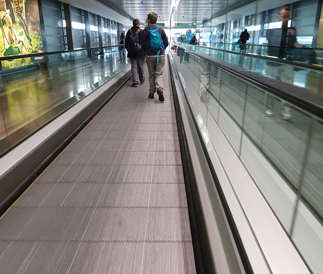The plastic trays used at airport security checkpoints have been found to harbour the highest levels of viruses at airports, a study has found. The University of Nottingham and the Finnish National Institute for Health and Welfare swabbed a variety of surfaces at Helsinki-Vantaa airport in Finland during the winter of 2016. They set out to identify and quantify the respiratory viruses on frequently-touched surfaces in airports. They found evidence of viruses on 10 per cent of the surfaces tested and most commonly on the plastic trays that are circulated along the passenger queue at the hand luggage X-ray checkpoint.
The investigation, published in BMC Infectious Diseases, concludes that hand washing and careful coughing hygiene are crucial to the control of contagious infections in public areas with high volumes of people passing through. The study was part of a larger EU-funded research project, PANDHUB, to look at the role of airports and other traffic hubs in the spread of serious infections. The findings add weight to previous studies showing that microbes are commonly found on surfaces in public transport vehicles and will strengthen public health advice in preparation for future flu pandemics.
At Helsinki-Vantaa airport, the highest concentration of viruses was detected on the security check plastic trays with further viruses detected on shop payment terminals, staircase rails, passport checking counters, children’s play areas and in the air.
The most common virus found in the survey was rhinovirus, which causes the common cold but the swabs also picked up the influenza A virus. No respiratory viruses were found on toilet surfaces.
Professor of Health Protection, Jonathan Van Tam, from the University’s School of Medicine, said: “This study supports the case for improved public awareness of how viral infections spread. People can help to minimise contagion by hygienic hand washing and coughing into a hankerchief, tissue or sleeve at all times but especially in public places. These simple precautions can help prevent pandemics and are most important in crowded areas like airports that have a high volume of people travelling to and from many different parts of the world.”
Virologist Niina Ikonen from the Finnish National Institute for Health and Welfare said: “The presence of microbes in the environment of an airport has not been investigated previously. The new findings support preparedness planning for controlling the spread of serious infectious diseases in airports. The results also provide new ideas for technical improvements in airport design and refurbishment.”
The airport study was carried out during and after peak passenger density at the airport by a method which detects genetic material from viruses on surfaces and in the air. The results provided by this method do not prove that the viruses found on surfaces and air are alive and cause disease, the researchers added, but previous experimental research has proven that many microbes survive on various surface materials up to several days.









